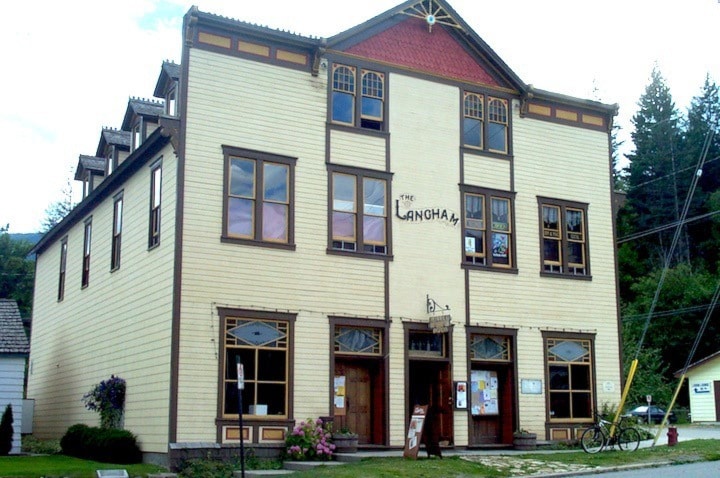First in a series
Kaslo’s Langham Cultural Centre is a remarkable building. With its wonderful old staircase, dormer windows, stained-glass windows, and original woodwork, it gives us a very good sense of a Victorian-era hotel or rooming house. Moreover it’s one of few survivors of its era and type in West Kootenay.
Other such buildings have burned in recent years, including the Silver Ledge in Ainsworth, while a few like the Leland in Nakusp and Ymir Hotel are of similar vintage but have been extensively renovated.
The Langham is so authentic and its survival so improbable that it almost feels like it shouldn’t be there — and it wouldn’t be if not for a group organized by Michael Guthrie that heroically rescued and transformed the once-derelict building in the mid-1970s.
The Langham recently celebrated its 40th anniversary as the village’s arts and culture hub with a gala weekend that included a terrific exhibit about its last four decades.
Elsewhere within its corridors, Ian Fraser has developed an excellent museum about the Japanese-Canadian internment in Kaslo during World War II, and documented the building’s role in that sad chapter of Canadian history. (It was this part of its history that recently led a panel of judges to name it one of BC’s best buildings.)
But not a lot is known about the Langham’s first 45 years or so, which are usually summed up in a few sentences. In the first installment of this series, we’ll try to answer two simple but vexing questions: who built the Langham and when?
Tale told in taxes
A BC Heritage Trust plaque on the building gives an 1893 date of construction, but it’s wrong.
The book Heritage Homes and Buildings of Kaslo, published in 1992, says the Langham “was erected in 1895 at the end of the boom period … by a woman who owned a stage line that went to the mines west of town.” That’s also wrong.
More accurate is the Canadian Register of Historic Places website, which gives the date of construction as 1896 and the builder as Charles J. Kapps.
Tax records held by the Kootenay Lake archives for 1894, the earliest available, show the two lots the Langham now sits on — Block 10, Lots 23 and 24 — were owned by Francis Beattie. With partner W.J. Saunders, Beattie ran the Montana Hotel on Front Street, which burned in Kaslo’s great fire that year. He was at the time also recently elected to city council, but moved to Banff that fall, and his seat was declared vacant.
(Someone probably concluded Beattie was a woman on account of his first name and decided he must have built the Langham by virtue of owning the property, but there’s no sign that he ran a stage line.)
The future Langham properties were then valued at $325 and $375 and the improvements at $100, which suggest a modest building. In 1895, Beattie was still listed as the owner, but the property values had decreased to $305 and $340.
A tenant named Flaherty — probably Michael Flaherty, listed in the 1894 civic directory as working at the Dardanelles Hotel on Front Street — was paying taxes on the building, valued at $40.
In 1896, Charles Joseph (Carl) Kapps is shown as the new owner of the lots, now worth $300 and $350 with $75 worth of improvements. In 1897 the value of Kapps’ land suddenly jumps to $750 and $800 and the improvements to $2,500 — a sure sign the Langham had been built.
Next: Birth of the Langham
